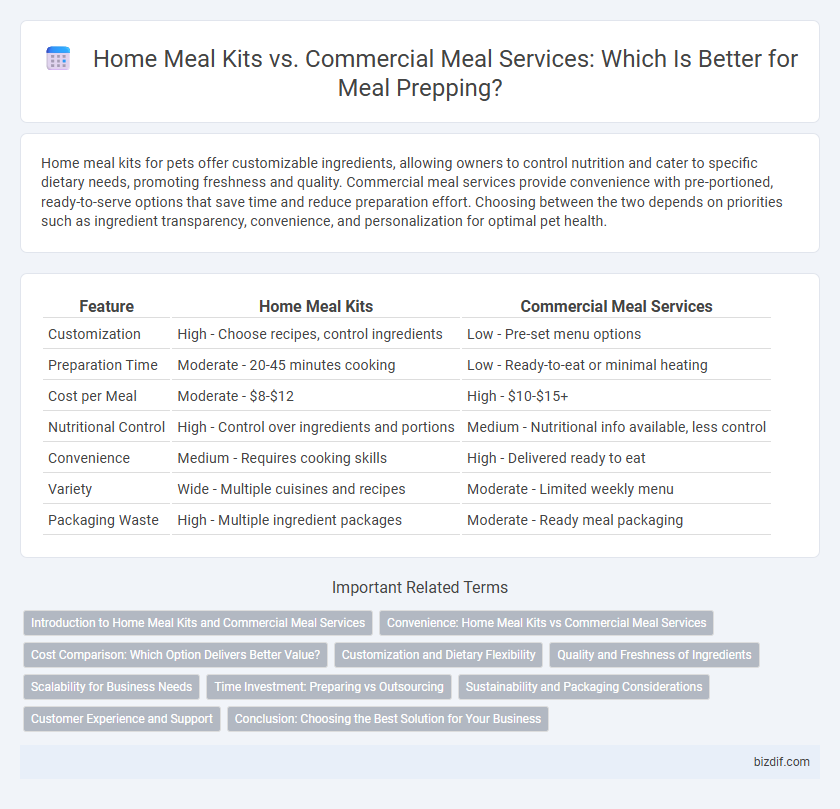Home meal kits for pets offer customizable ingredients, allowing owners to control nutrition and cater to specific dietary needs, promoting freshness and quality. Commercial meal services provide convenience with pre-portioned, ready-to-serve options that save time and reduce preparation effort. Choosing between the two depends on priorities such as ingredient transparency, convenience, and personalization for optimal pet health.
Table of Comparison
| Feature | Home Meal Kits | Commercial Meal Services |
|---|---|---|
| Customization | High - Choose recipes, control ingredients | Low - Pre-set menu options |
| Preparation Time | Moderate - 20-45 minutes cooking | Low - Ready-to-eat or minimal heating |
| Cost per Meal | Moderate - $8-$12 | High - $10-$15+ |
| Nutritional Control | High - Control over ingredients and portions | Medium - Nutritional info available, less control |
| Convenience | Medium - Requires cooking skills | High - Delivered ready to eat |
| Variety | Wide - Multiple cuisines and recipes | Moderate - Limited weekly menu |
| Packaging Waste | High - Multiple ingredient packages | Moderate - Ready meal packaging |
Introduction to Home Meal Kits and Commercial Meal Services
Home meal kits provide pre-portioned ingredients and recipes designed for convenient, customized cooking experiences at home, promoting freshness and control over meal options. Commercial meal services typically offer ready-to-eat or heat-and-serve meals that prioritize speed and convenience for busy lifestyles. Both options cater to different dietary needs and preferences, balancing convenience with home-cooked quality.
Convenience: Home Meal Kits vs Commercial Meal Services
Home meal kits offer the convenience of pre-portioned ingredients with step-by-step recipes, reducing grocery shopping time and food waste, ideal for users seeking hands-on cooking without planning. Commercial meal services provide fully prepared meals requiring minimal or no cooking, appealing to individuals with limited time or cooking skills. Both options enhance mealtime efficiency but differ in preparation effort and personalization flexibility.
Cost Comparison: Which Option Delivers Better Value?
Home meal kits typically offer better cost efficiency by allowing users to purchase ingredients in bulk and customize portions, reducing waste and overall expenses. Commercial meal services often include higher convenience fees and premium pricing for pre-prepared meals, which can increase the total cost per serving. Evaluating long-term savings, home meal kits generally deliver superior value through ingredient control and meal variety compared to the consistently higher costs of commercial services.
Customization and Dietary Flexibility
Home meal kits offer extensive customization options, allowing individuals to select ingredients that cater specifically to allergies, dietary preferences, and portion sizes. Commercial meal services often provide fixed menus with limited flexibility, focusing on convenience over personalized nutrition. Emphasizing dietary flexibility, home meal kits enable users to experiment with diverse cuisines and adapt meals to evolving health goals more effectively than standard commercial offerings.
Quality and Freshness of Ingredients
Home meal kits typically provide fresher ingredients sourced directly from local farms or trusted suppliers, ensuring higher quality and minimal processing. Commercial meal services often rely on bulk purchasing and longer storage times, which can compromise the freshness and nutrient content of their ingredients. Choosing home meal kits allows for greater control over ingredient quality, supporting healthier and more flavorful meals.
Scalability for Business Needs
Home meal kits offer customizable scalability by allowing businesses to adjust portion sizes and ingredient combinations based on customer demand and seasonal availability. Commercial meal services provide streamlined scalability through bulk purchasing and standardized menus that optimize production efficiency but may limit personalized options. Both models can support growth, with home meal kits excelling in flexibility and commercial services in high-volume consistency.
Time Investment: Preparing vs Outsourcing
Home meal kits require a moderate time investment to select, prepare, and cook ingredients, often streamlining the cooking process with pre-measured portions and step-by-step instructions. Commercial meal services save time by delivering fully prepared or ready-to-cook meals, eliminating the need for chopping, measuring, and cooking planning. Consumers balance convenience and control, as meal kits demand hands-on preparation while commercial services prioritize time-saving through outsourcing culinary tasks.
Sustainability and Packaging Considerations
Home meal kits typically offer greater sustainability benefits due to reduced transportation emissions and customizable portions that minimize food waste. Commercial meal services often use single-use plastic packaging, although some are transitioning to biodegradable or recyclable materials to address environmental concerns. Choosing home meal kits with reusable containers and local ingredient sourcing enhances eco-friendly meal preparation.
Customer Experience and Support
Home meal kits offer personalized customer support through direct interaction with local suppliers, enhancing customer satisfaction and trust. Commercial meal services provide streamlined customer experience with easy-to-navigate platforms, reliable delivery schedules, and 24/7 customer service access. The choice between these options hinges on prioritizing tailored assistance versus convenience and scalability.
Conclusion: Choosing the Best Solution for Your Business
Home meal kits offer customization, cost efficiency, and control over ingredient quality, making them ideal for businesses prioritizing brand uniqueness and customer experience. Commercial meal services provide scalability, consistent logistics, and reduced operational complexity, suited for businesses focused on rapid expansion and streamlined supply chains. Evaluating target market preferences, production capabilities, and long-term growth goals helps determine the best solution for a business's meal prep strategy.
Home meal kits vs commercial meal services Infographic

 bizdif.com
bizdif.com